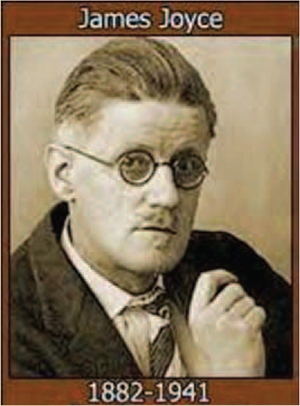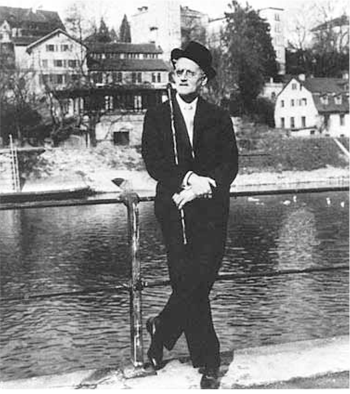
 Why is June 16th called "Bloomsday" and what is all the fuss about? If you are an expert on James Joyce and his masterpiece, ULYSSES, there's no need for you to read this. For those of you who have tried to read ULYSSES in the past and thought it sounded like gibberish - join the crowd. The majority of readers never make it past Chapter Three. If you are looking for a book that is a challenge, that you can try to decipher and analyze for weeks, months, perhaps the rest of your life - ULYSSES is the book. If you have neither the time nor the desire, this article is for you. The following is James Joyce's ULYSSES in a nutshell.
Why is June 16th called "Bloomsday" and what is all the fuss about? If you are an expert on James Joyce and his masterpiece, ULYSSES, there's no need for you to read this. For those of you who have tried to read ULYSSES in the past and thought it sounded like gibberish - join the crowd. The majority of readers never make it past Chapter Three. If you are looking for a book that is a challenge, that you can try to decipher and analyze for weeks, months, perhaps the rest of your life - ULYSSES is the book. If you have neither the time nor the desire, this article is for you. The following is James Joyce's ULYSSES in a nutshell.
First of all, why is James Joyce considered one of the greatest writers of the 20th century if he wrote basically unreadable gibberish and why is the book ULYSSES considered his masterpiece and one of the greatest books of all time? Compare it to the Impressionist artists. They tried painting in a new way and most of the public ridiculed their work . These artists didn't believe that true art should remain stagnant. The same happened with literature. Writers wanted to grow - to advance - to take writing to new levels. Up until the beginnings of "modern writing" in England, novels had followed a basic form. Their books were about the upper classes. They always had a moral - usually that good and love conquered all. And they always had a happy ending. These stories progressed through a linear time-line from a beginning to an end. James Joyce, Virginia Woolf, and D.H. Lawrence are considered to be the first modern writers in English. They manipulated time. They went inside the heads of their characters and with a "stream of consciousness" showingwhat the characters were thinking - not just what was happening. Having a moral was not necessary. It was the telling that mattered. These writers wanted to go beyond traditional means of expression.
ULYSSES was first published in France. It was considered scandalous and banned in Great Britain and the United States. Worthy of note is the fact that the major backers fighting for its publication were women - American women. They went to court to get it cleared for publication. This was not a book written at the end of an illustrious career. Joyce was thirty-five years old when he began writing it. The book was published on his 40th birthday, February 22nd, 1922. Although it was called dirty, blasphemous, and unreadable - a famous court decision in 1933 allowed its importation into the United States. Among its appreciative readers were Winston Churchill and Earnest Hemingway, who called it, "the most important book of the century." It is a difficult book to read because Joyce employed a different method or device in almost every chapter. He used incomplete sentences, metaphors, parodies, puns, religious and political references. He took Celtic lyricism to hither-unknown extremes. Joyce wanted his text to be a mystery to readers. He said, "It will take professors and readers years to decipher all the paradoxes that I have hidden within these pages." Just when a reader begins to think they are getting the hang of what the author is doing - he changes direction. Why was it scandalous? Joyce wrote about things that had never been written about before - and in detail. His hero reads the newspaper while having a bowel movement, and later pees behind a tree. He masturbates in the bathtub, and again later while watching a young girl at the beach. The hero's wife has an affair with another man - at their home - and the hero knows about it and does nothing - even when he climbs in bed that night and finds a wet spot there. This was definitely not the writings of Jane Austin or the Bronte siblings. Joyce roughly used Homer's tale of Ulysses as his model - hence the name. It is a story of a hero that leaves home - encounters strange characters and adventures in his wanderings and then returns home to his wife. If one recalls Homer's tale of Ulysses - the hero has been to Troy fighting in the infamous Trojan War. For the past ten years he has been attempting to return home to the island of Ithaca, his wife Penelope and his son Telemachus. During his travels he encounters such creatures as Calypso (the beautiful nymph that holds Ulysses captive for seven years) - the Sirens (beautiful singing mermaids that Joyce reincarnates as barmaids) - and the one-eyed Cyclops. Joyce uses Bloom's attending the funeral of an acquaintance as his trip to the Underworld. Whereas, Ulysses wandered for twenty years, our hero's travels are all in one day - June 16, 1904. There are three main characters, Leopold Bloom (hence the name Bloomsday), his wife Molly Bloom, and a young man, Stephen Dedalus. These three characters represent Ulysses, his wife Penelope, and his young son (although Stephen is not his son.) Interestingly, Joyce's alter ego is not the hero Leopold, but instead is Stephen. Joyce had used this same name for his alter ego in another of his books. We don't meet the hero, Leopold until Chapter Four. The first three chapters are about Stephen. But Leopold is definitely the hero.
We barely encounter Molly throughout the entire story, except in the thoughts of Leopold. She is far from the faithful Penelope of Homer's epic, that waited chastely twenty years for her husband to return. Molly, a singer, has an affair with Blaze Boylan, her agent. But we also discover that Molly and Leopold have not had sex for ten years, although they sleep in the same bed. The reason is never entirely clear, although we know they lost their infant son that many years ago. We also know that Joyce and Nora Barnacle, his life in real life, had sexual issues as well. These were related to Roman Catholicism and the banned use of birth control. In the story, although Leopold doesn't satisfy his wife, he does ogle other women and make her jealous. We also find that Leopold has several strange sexual peccadilloes throughout the story. This was shocking to the public. These things were just NOT discussed in literature in 1922. However, Leopold does confess that Molly is the love of his life - as he is hers. Many believe that the entire book is a tribute to Joyce's wife, Nora who he met on June 16th, 1904. (Does that date sound familiar?) The entire last chapter and the erotic ending of the tale are the rambling thoughts of a sleepy Molly in the early morning hours. It meanders for 45 pages - in only eight sentences and no punctuation, which makes it strange to read. In the end her thoughts return to Leopold when they first met and how she felt about him. The last lines read, "shall I wear a red yes and how he kissed me under the Moorish wall and I thought well as well him as another and then I asked him with my eyes to ask again yes and then he asked me would I yes to say yes my mountain flower and first I put my arms around him yes and drew him down to me so he could feel my breasts all perfume yes and his heart was going like mad and yes I said yes I will Yes." (Shades of Meg Ryan in "When Harry met Sally.")
 It is ironic that Ireland, that once considered Joyce and his book obscene, today celebrates Bloomsday enthusiastically. Joyce felt Ireland sacrificed all of its prophets. He and his wife Nora Barnacle, a 20 year old chambermaid, left Ireland four months after they met. They didn't marry until years later. They did make a few early visits home but never returned after 1912. He felt to write about Ireland - he had to be removed. The couple lived instead in Zurich, Trieste, and Paris. Joyce died in Zurich, Switzerland, on January 13, 1941 (as the result of an undiagnosed duodenal ulcer) and is buried there. But it was Ireland that he knew best and that he wrote about. In ULYSSES Joyce has written about the city of Dublin so precisely, that he said any visitor that read his book could find their way around the city. Visitors to Dublin today will see plaques and signs denoting specific locations that Joyce had mentioned in ULYSSES. Bloomsday is a major event in Ireland now and a major tourist attraction. Many Irish people believe it is a better reflection of the true Irish culture – than St. Patrick's Day. Bloomsday points to the Irish love of literature and writing. When in Ireland I met a taxi driver that said he had read ULYSSES eleven times. It may be true - or he may have kissed the Blarney Stone one too many times. This year when June 16th rolls around, let me be one of the first to tip my hat to ye and say - HAPPY BLOOMSDAY!
It is ironic that Ireland, that once considered Joyce and his book obscene, today celebrates Bloomsday enthusiastically. Joyce felt Ireland sacrificed all of its prophets. He and his wife Nora Barnacle, a 20 year old chambermaid, left Ireland four months after they met. They didn't marry until years later. They did make a few early visits home but never returned after 1912. He felt to write about Ireland - he had to be removed. The couple lived instead in Zurich, Trieste, and Paris. Joyce died in Zurich, Switzerland, on January 13, 1941 (as the result of an undiagnosed duodenal ulcer) and is buried there. But it was Ireland that he knew best and that he wrote about. In ULYSSES Joyce has written about the city of Dublin so precisely, that he said any visitor that read his book could find their way around the city. Visitors to Dublin today will see plaques and signs denoting specific locations that Joyce had mentioned in ULYSSES. Bloomsday is a major event in Ireland now and a major tourist attraction. Many Irish people believe it is a better reflection of the true Irish culture – than St. Patrick's Day. Bloomsday points to the Irish love of literature and writing. When in Ireland I met a taxi driver that said he had read ULYSSES eleven times. It may be true - or he may have kissed the Blarney Stone one too many times. This year when June 16th rolls around, let me be one of the first to tip my hat to ye and say - HAPPY BLOOMSDAY!